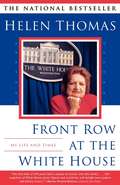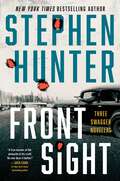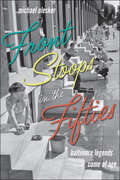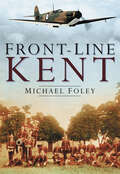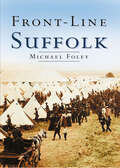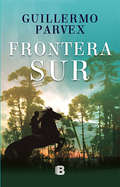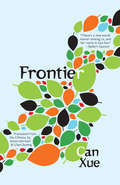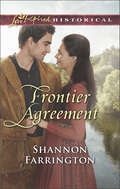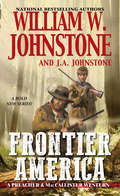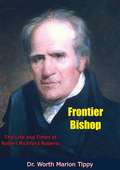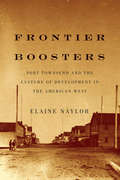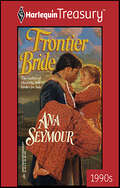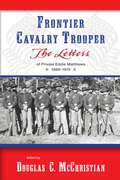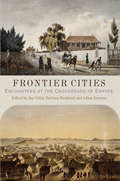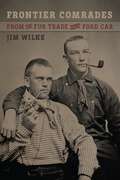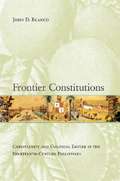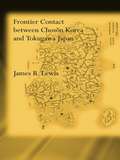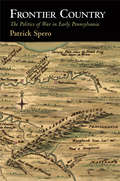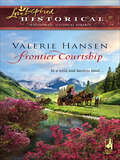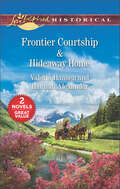- Table View
- List View
Front Row at the White House: My Life and Times
by Helen Thomas"I'm still here, still arriving at the White House in the wee hours of the morning, reading the papers and checking the wire, still waiting for the morning briefing, still sitting down to write the first story of the day and still waiting to ask the tough questions." From the woman who has reported on every president from Kennedy to Clinton for United Press International: a unique glimpse into the White House -- and a telling record of the ever-changing relationship between the presidency and the press. From her earliest years, Helen Thomas wanted to be a reporter. Raised in Depression-era Detroit, she worked her way to Washington after college and, unlike other women reporters who gave up their jobs to returning veterans, parlayed her copy-aide job at the Washington Daily News into a twelve-year stint as a radio news writer for UPI, covering such beats as the Department of Justice and other federal agencies. Assigned to the White House press corps in 1961, Thomas was the first woman to close a press conference with "Thank you, Mr. President," and has covered every administration since Kennedy's. Along the way, she was among the pioneers who broke down barriers against women in the national media, becoming the first female president of the White House Correspondents Association, the first female officer of the National Press Club and the first woman member, later president, of the Gridiron Club. In this revealing memoir, which includes hundreds of anecdotes, insights, observations, and personal details, Thomas looks back at a career spent with presidents at home and abroad, on the ground and in the air. She evaluates the enormous changes that Watergate brought, including diminished press access to the Oval Office, and how they have affected every president since Nixon. Providing a unique view of the past four decades of presidential history, Front Row at the White House offers a seasoned study of the relationship between the chief executive officer and the press -- a relationship that is sometimes uneasy, sometimes playful, yet always integral to democracy. "Soon enough there will be another president, another first lady, another press secretary and a whole new administration to discover. I'm looking forward to it -- although I'm sure whoever ends up in the Oval Office in a new century may not be so thrilled about the prospect."
Front Sight: Three Swagger Novellas (Earl Swagger)
by Stephen HunterA collection of three interconnected novellas that follow each generation of the iconic Swagger family—grandfather Charles, father Earl, and fan favorite hero Bob Lee—from New York Times bestselling author, Pulitzer Prize winner, and &“true master at the pinnacle of his craft&” (Jack Carr, #1 New York Times bestselling author) Stephen Hunter.In City of Meat, Charles Swagger is on the hunt for notorious bank robber Baby Face Nelson when he traces a tip to the Chicago stock yards. While there, he&’s brutally assaulted by a madman involved in a nearby narcotics ring. The ring plans to spread its new drug to the residents of the disenfranchised 7th District of Chicago and to make matters worse, this is no ordinary drug—it makes some users happy, drives others insane, and kills many of the rest. Will Charles be able to stop the ring before it&’s too late? Or is he in over his head among the dark streets of Chicago? Earl Swagger investigates a violent bank robbery that left two dead and a fortune missing in small-town Maryland in Johnny Tuesday. At every turn, however, he&’s met with silence and hostility from the townsfolk, which makes sense when he uncovers municipal corruption, gang politics, jaded aristocrats, scheming gamblers, a hitman, a femme fatale, and a whole bunch of men with guns. Luckily, Earl has brought his own guns in this unputdownable noir mystery. Finally, in Five Dolls for the Gut Hook, a thirty-two-year-old Bob Lee Swagger is back from Vietnam nearly broken over good men lost for nothing. He&’s turned down that whiskey road to hell. But one afternoon he&’s awakened from his nightmares by two men with a problem. As nearby Hot Springs tries to retool its image from gambling paradise to family resort, a butcher has begun to prey on the city&’s young women, a figure straight out of a horror movie. Hot Springs Homicide is baffled and recruit Bob&’s help. &“I&’m a sniper,&” says Bob, &“not a detective.&” &“But,&” comes the reply, &“you are the son and grandson of two of the greatest detectives this state has ever produced.&” On that premise alone, Bob takes up the hunt for a killer who not only kills but desecrates. At the same time, we understand that Bob Lee Swagger is also hunting for his own salvation.
Front Stage: முன் மேடை
by A. Ramasamyநாடகக் கதையைத் தொடங்குவதற்கு முன்பு பார்வையாளர்களை ஒருவிதக் களிப்பு மனநிலையில் நிலைகொள்ளச் செய்து அன்றையமேடை நிகழ்விற்கு தயார்ப்படுத்தும் பணிகளைத் தெருகூத்தின் கட்டியங்காரனும், ஸ்பெஷல் நாடகத்தின் பபூனும் செய்வான். கூத்திலும் சரி, ஸ்பெஷல் நாடகத்திலும் சரி, இந்த அம்சம் தவிர்க்க முடியாத அம்சங்களாகப் பார்வையாளர்கள் கருதினார்கள். ஸ்பெஷல் நாடகங்களில் பபூன் -காமிக் நடைபெறும் வரை கூட்டம் அலைமோதும். கதையின் மையப் பாத்திரங்கள் வரும்போது கூட்டம் குறையும் பின்னர் முக்கியமான தர்க்கங்களின் போது தூங்கியவர்கள் விழித்துக் கொள்வார்கள்.
Front Stoops in the Fifties: Baltimore Legends Come of Age
by Michael OleskerFamous Baltimoreans growing up in the fifties.Front Stoops in the Fifties recounts the stories of some of Baltimore's most famous personalities as they grew up during the "decade of conformity." Such familiar names as Jerry Leiber, Nancy Pelosi, Thurgood Marshall, and Barry Levinson figure prominently in Michael Olesker’s gripping account, which draws on personal interviews and journalistic digging.Olesker marks the end of the fifties with the assassination of President John F. Kennedy. "It’s as if millions will suddenly decide to act out their anxieties and their rage, as if Kennedy’s murder exposed some hypocrisy at the heart of the American dream," he writes. Focusing on the period leading up to this turning point in U.S. history, Olesker looks to the individuals living through the changes that were just beginning to surface and would later come to prominence in the sixties.The fifties are often remembered with longing as a more innocent time. But it was also a suffocating time for many. Alongside innocence was ignorance. Olesker tells the story of Nancy D’Alesandro Pelosi, daughter of the mayor, who grew up in a political home and eventually became the first woman Speaker of the House. Thurgood Marshall, schooled in a racially segregated classroom, went on to argue Brown v. Board of Education of Topeka before the U.S. Supreme Court and rewrite race-relations law. Even the music changed. Olesker’s doo-wop portrait of Baltimore is nostalgic, but it has a hard edge.
Front Stoops in the Fifties: Baltimore Legends Come of Age
by Michael OleskerThis personal history of prominent Baltimoreans sheds light on the social transformations already taking place in the supposedly innocent 1950s. Front Stoops in the Fifties recounts the stories of some of Baltimore&’s most famous personalities as they grew up during the &“decade of conformity&”—just before they entered the turbulent 1960s. Focusing on the period before JFK&’s assassination, Olesker looks to individuals who would go on to influence the brewing cultural revolution. Such familiar names as Jerry Leiber, Nancy Pelosi, Thurgood Marshall, and Barry Levinson figure prominently in Michael Olesker&’s fascinating account, which draws on personal interviews and journalistic research. Olesker tells the story of Nancy D&’Alesandro Pelosi, daughter of the mayor, who grew up in a political home and eventually became the first woman Speaker of the House. Thurgood Marshall, schooled in a racially segregated classroom, went on to argue Brown v. Board of Education of Topeka before the U.S. Supreme Court and rewrite race-relations law. These and many other stories come to life in Front Stoops in the Fifties. &“[A] fascinating read . . . The shocking part is just how relevant these stories remain today.&” —Baltimore Post-Examiner &“[A] crisp, insightful dispatch from a skilled writer who knows his city and its history.&” —David Simon, executive producer of HBO&’s The Wire
Front-Line Kent
by Michael FoleyKent has been on England's first line of defence. In all major conflicts many people in the county have lived closer to the enemy in Europe than they did to London. Much of the county's coastline has been the site of training and weapon development, which adds to the interest of military sites in this area. Michael Foley's new book delves into the long history of military Kent, from Roman forts to Martello towers, built to keep Napoleon out, from the ambitious Royal Military Canal, which cost an equivalent of GBP10 million in today's money but was abandoned after seventy years, to wartime airfields and underground Cold War installations. Illustrated with a wide range of photographs, maps, drawings, engravings and paintings, Front-Line Kent also includes location and access details for the sites that are illustrated and described. This lively and informative book will appeal to anyone interested in Kent's history, whether or not a military specialist.
Front-Page Scotland: Newspapers and the Scottish Independence Referendum (Routledge Focus on Journalism Studies)
by David PatrickThis book provides a varied, thorough and informative analysis of how newspapers covered the 2014 Scottish independence referendum in its critical final months. Providing a wealth of new empirical findings, the book engages with the key themes and issues which emerge from within the discourses themselves. Among the main observations are: the marginalisation of women, both as subjects and producers of the news; the late emergence of the London-based media to take the vote entirely seriously; the often myopic focus on Alex Salmond; and the framing of the debate through contrasting narratives of positive democratic engagement and societal division within Scotland. The book will be the first point of contact for readers interested in the subject, providing an overview which is meticulously researched, authoritative and engaging, and offering broader insights in the areas of journalism, political communication and media studies.
Front-line Suffolk
by Michael FoleySuffolk's coastline faces east, and through most of its history has therefore been one of the areas of this country that has been at risk from invasion during times of conflict. This title delves into history of military Suffolk, from Saxon shore forts to castles or castle sites, Napoleonic martello towers and Second World War airfields.
Frontera sur
by Guillermo ParvexLa historia del Wallmapu contada a través de Pedro Borquez, un chileno que rompe sus prejuicios y se va a vivir con los mapuche. Novela histórica ambientada en el siglo XIX (1835-1859) en Chile; la historia se enmarca en una época en que la naciente república de Chile y la nación mapuche mantenían una relación entre estados, a veces no exenta de roces, pero que en general se caracterizó por una sana y pacífica convivencia, con territorios y atribuciones claramente delimitados, en que fluían en forma normal las actividades comerciales y las relaciones políticas y militares.
Frontier
by Chen Zeping Karen Gernant Can Xue Porochista KhakpourThough the story of Liujin, a young woman seeking a new kind of human freedom, Frontier attempts to unify the grand opposites of life--barbarism and civilization, the spiritual and the material, the mundane and the sublime, beauty and death, Eastern and Western cultures. A layered, multifaceted masterpiece from the 2015 winner of the Best Translated Book Award.
Frontier Agreement
by Shannon FarringtonFORCED TO WED When half-Native American translator Claire Manette joins her mother's tribe after her father's death, she's told she must marry or leave the village. Lewis and Clark expedition member Pierre Lafayette's offer of a marriage of convenience is enticing. But with her refusal to leave her family behind and his dreams of exploring uncharted territories, it would never work. Pierre joined the expedition for adventure...and to avoid settling down. So why does he feel compelled to protect a stranger by marrying her? The only thing he's sure of is that he can't allow Claire to be forced from the only home she has left. Pierre and Claire are an unlikely match, but amid the wilderness of the West, could his offer of duty become one of love?
Frontier America (A Preacher & MacCallister Western #1)
by William W. Johnstone J.A. JohnstonePREACHER + MacCALLISTER = DOUBLE THE MAYHEM Two of the Johnstones’ most legendary heroes—the rugged mountain man known as Preacher and the Scottish clan rancher Jamie Ian MacCallister, here together for the first time—are forced to choose sides in a blood-soaked battle for the heart and soul of a nation divided . . . FRONTIER AMERICA As the father of a young Crow tribesman, Preacher would like nothing more than to see the long-time natives and newly arrived settlers live together in peace. Then the killing starts . . . As a family man and frontiersman, Jamie Ian MacCallister is more than happy to help the officers at Fort Kearny negotiate a peace treaty with the Crow nation. Until it all goes to hell . . . This is not the American dream they were looking for. This is a nightmare. A brutal, blood-drenched frontier war that two heroic men must fight and win—or one struggling nation will never come together. For liberty and justice for all . . . Live Free. Read Hard.
Frontier Bishop: The Life and Times of Robert Richford Roberts
by Dr Worth Marion TippyThis book, written by Dr. Worth Marion Tippy in 1958, is a biography of Robert Richford Roberts (1778-1843), an American Methodist Circuit Rider, Pastor, Presiding Elder, and the first married man in America to serve as Bishop of the Methodist Episcopal Church, elected in 1816.Born in Frederick County, Maryland, his family were communicants of The Church of England. In 1785, they moved to the Ligonier Valley in Westmoreland County, Pennsylvania, where Roberts united with the M.E. Church when he was fourteen years old. Until he was twenty-one, his was a thoroughly frontier existence, with few books and quite simple habits. Despite becoming one of the “foremost religious leaders of his time,” he remained a frontiersman to the day of his death in 1843.“Long after he became a bishop he liked to follow deer in the forest. When he was free, being now a bishop, to live where he chose, he established his episcopal residence in what was then wilderness of the hill country of southern Indiana. Here, in utmost seclusion, he lived for the next quarter century, at first under most primitive conditions. From this isolated place he left on horseback on his amazing episcopal journeys to all parts of the nation, returning after long absences to work on his lands.”Dr. Tippy tells of Bishop Roberts’ move from his native Maryland to the then-frontier of western Pennsylvania, where his father had secured four hundred acres of land in the Ligonier Valley fifty miles east of Pittsburgh, and where the young Roberts would go on to experience the hardships and adventures of migrants before and after him—experiences which “better prepared for the leadership which came to him so early in life.”An invaluable read.
Frontier Boosters
by Elaine NaylorFrontier Boosters is a compelling social history of urbanization and economic development in the nineteenth-century American West. Focusing on Port Townsend, Washington and the surrounding Puget Sound region, Elaine Naylor examines economic development, "boosterism," and the dynamics of class and race in frontier settlement. In the late-nineteenth century, Seattle had not yet fully emerged as the premier city of the Pacific Northwest, and the residents of Port Townsend had every reason to imagine their town - located at the entrance to Puget Sound, the waterway for the timber resources that drove Washington's frontier economy - as the region's burgeoning metropolis. Naylor argues that the promotion of local economic development, defined as boosterism and commonly linked with land speculators, investors, and businessmen, was in fact embraced by ordinary frontier citizens. As such a "booster" mentality became integrated into Port Townsend's social dynamics, shaping the town's class and race relations, specifically between its Euro-American, Native American, and Chinese communities. Frontier Boosters illuminates the importance of economic development to ordinary settlers and highlights the complex interrelationship between the social dynamics of class and race within the context of the American frontier.
Frontier Boosters: Port Townsend and the Culture of Development in the American West
by Elaine NaylorFrontier Boosters is a compelling social history of urbanization and economic development in the nineteenth-century American West. Focusing on Port Townsend, Washington and the surrounding Puget Sound region, Elaine Naylor examines economic development, "boosterism," and the dynamics of class and race in frontier settlement. In the late-nineteenth century, Seattle had not yet fully emerged as the premier city of the Pacific Northwest, and the residents of Port Townsend had every reason to imagine their town - located at the entrance to Puget Sound, the waterway for the timber resources that drove Washington's frontier economy - as the region's burgeoning metropolis. Naylor argues that the promotion of local economic development, defined as boosterism and commonly linked with land speculators, investors, and businessmen, was in fact embraced by ordinary frontier citizens. As such a "booster" mentality became integrated into Port Townsend's social dynamics, shaping the town's class and race relations, specifically between its Euro-American, Native American, and Chinese communities. Frontier Boosters illuminates the importance of economic development to ordinary settlers and highlights the complex interrelationship between the social dynamics of class and race within the context of the American frontier.
Frontier Bride
by Ana SeymourHannah Forrester's life did not belong to her. ... A contract of indenture saw to that. But no one owned her soul, and Ethan Reed knew instinctively that she was the one woman who belonged by his side, for now and forever. Rugged as the frontier he roamed, Ethan had left his mark on Hannah's heart. Yet, though he'd guided her through a new land of wonder, she knew his rambling ways could only lead her astray.
Frontier Bride
by Ana SeymourHannah Forrester's Life Did Not Belong To HerA contract of indenture saw to that. But no one owned her soul, and Ethan Reed knew instinctively that she was the one woman who belonged by his side, for now and forever.Rugged as the frontier he roamed, Ethan had left his mark on Hannah's heart. Yet, though he'd guided her through a new land of wonder, she knew his rambling ways could only lead her astray.
Frontier Cavalry Trooper: The Letters of Private Eddie Matthews, 1869–1874
by Douglas C. McChristianDuring his five years in the army, Private Edward L. Matthews wrote a series of exceptionally detailed and engaging letters to his family back home in Maryland describing his life in the Arizona and New Mexico Territories. Eddie Matthews&’s letters, published here for the first time, provide an unparalleled chronicle of one soldier&’s experiences in garrison and in the field in the post–Civil War Southwest.Eddie&’s letters record a vivid chronicle of day-to-day life in the frontier regulars. Included are operational details in his company, candid observations of people and places, intimate views of frontier society, and personal opinions that probably would have been forgotten or moderated had he recorded his experiences later in life. More subtle are his valuable references to the state of transportation and communication in the Southwest during the early 1870s. Matthews probably did not realize until later years that he was not only a witness to the nation&’s rapid westward expansion, but was himself a tiny cog in the machinery that made it possible.
Frontier Cities
by Jay Gitlin Barbara Berglund Adam ArensonMacau, New Orleans, St. Louis, Pittsburgh, and San Francisco. All of these metropolitan centers were once frontier cities, urban areas irrevocably shaped by cross-cultural borderland beginnings. Spanning a wide range of periods and locations, and including stories of eighteenth-century Detroit, nineteenth-century Seattle, and twentieth-century Los Angeles, Frontier Cities recovers the history of these urban places and shows how, from the start, natives and newcomers alike shared streets, buildings, and interwoven lives. Not only do frontier cities embody the earliest matrix of the American urban experience; they also testify to the intersections of colonial, urban, western, and global history.The twelve essays in this collection paint compelling portraits of frontier cities and their inhabitants: the French traders who bypassed imperial regulations by throwing casks of brandy over the wall to Indian customers in eighteenth-century Montreal; Isaac Friedlander, San Francisco's "Grain King"; and Adrien de Pauger, who designed the Vieux Carré in New Orleans. Exploring the economic and political networks, imperial ambitions, and personal intimacies of frontier city development, this collection demonstrates that these cities followed no mythic line of settlement, nor did they move lockstep through a certain pace or pattern of evolution. An introduction puts the collection in historical context, and the epilogue ponders the future of frontier cities in the midst of contemporary globalization. With innovative concepts and a rich selection of maps and images, Frontier Cities imparts a crucial untold chapter in the construction of urban history and place.
Frontier Comrades: From the Fur Trade to the Ford Car
by Jim WilkeFrontier Comrades examines six accounts of lesbian, gay, bisexual, and transgender lives on the frontier of the American West. Each account interprets this history through experiences that take place in different parts of the West, moving chronologically from the fur trade era to the dawn of the automobile age. Jim Wilke provides the first comprehensive accounts of figures such as transgender stage driver Charley Parkhurst; transgender Seventh Cavalry laundress Mrs. Noonan (also known as Mrs. Nash); and the extraordinary Clara Dietrich and Ora Chatfield, known by the contemporary press as &“lady lovers.&” Frontier Comrades also offers glimpses of individual personalities: the cool and detached grandeur of William Stewart as he traversed the West during the fur trade era; the stubborn determination of Charley Parkhurst after California&’s gold rush; the careful, giddy energy of Mrs. Noonan; the hidden passions of Tombstone sheriff William Breakenridge for a Vanderbilt and a local rustler; the desperate bravery of Dietrich and Chatfield as they sought to elope from Victorian Aspen; and the masculine, matter-of-fact comradeship of loggers and miners as they worked the distant Sierras. The maelstrom of opportunities and conflicts that made up the West affected lesbian, gay, bisexual, and transgender westerners in intrinsically personal ways. The accounts in Frontier Comrades provide an intimate yet expansive view of the American West.
Frontier Constitutions: Christianity and Colonial Empire in the Nineteenth-Century Philippines
by John D. BlancoA study of the cultural transformations arrived at by Spanish colonists, native-born creoles, mestizos (Chinese and Spanish), and indigenous colonial subjects in the Philippines during the crisis of colonial hegemony in the nineteenth century and the social anomie that resulted from this crisis in law and politics.
Frontier Contact Between Choson Korea and Tokugawa Japan
by James B. LewisEast Asia from 1400 to 1850 was a vibrant web of connections, and the southern coast of the Korean peninsula participated in a maritime world that stretched to Southeast Asia and beyond. Within this world were Japanese pirates, traders, and fishermen. They brought things to the Korean peninsula and they took things away. The economic and demographic structures of Kyongsang Province had deep and wide connections with these Japanese traders. Social and political clashes revolving around the Japan House in Pusan reveal Korean mentalities towards the Japanese connection. This study seeks to define 'Korea' by examining its frontier with Japan. The guiding problems are the relations between structures and agents and the self-definitions reached by pre-modern Koreans in their interaction with the Japanese. Case studies range from demography to taxation to trade to politics to prostitution. The study draws on a wide base of primary sources for Korea and Japan and introduces the problems that animate modern scholarship in both countries. It offers a model approach for Korea's northern frontier with China and shows that the peninsula was and is a complex brocade of differing regions. The book will be of interest to anyone concerned with pre-1900 East Asia, Korea in particular, and especially Korea's relations with the outside world. Anyone interested in early-modern Japan and its external relations will also find it essential reading.
Frontier Country: The Politics of War in Early Pennsylvania
by Patrick SperoIn Frontier Country, Patrick Spero addresses one of the most important and controversial subjects in American history: the frontier. Countering the modern conception of the American frontier as an area of expansion, Spero employs the eighteenth-century meaning of the term to show how colonists understood it as a vulnerable, militarized boundary. The Pennsylvania frontier, Spero argues, was constituted through conflicts not only between colonists and Native Americans but also among neighboring British colonies. These violent encounters created what Spero describes as a distinctive "frontier society" on the eve of the American Revolution that transformed the once-peaceful colony of Pennsylvania into a "frontier country."Spero narrates Pennsylvania's story through a sequence of formative but until now largely overlooked confrontations: an eight-year-long border war between Maryland and Pennsylvania in the 1730s; the Seven Years' War and conflicts with Native Americans in the 1750s; a series of frontier rebellions in the 1760s that rocked the colony and its governing elite; and wars Pennsylvania fought with Virginia and Connecticut in the 1770s over its western and northern borders. Deploying innovative data-mining and GIS-mapping techniques to produce a series of customized maps, he illustrates the growth and shifting locations of frontiers over time. Synthesizing the tensions between high and low politics and between eastern and western regions in Pennsylvania before the Revolution, Spero recasts the importance of frontiers to the development of colonial America and the origins of American Independence.
Frontier Courtship
by Valerie HansenA Journey of Hope... She had made a solemn promise to see her younger sister to safety in California. But the endless journey across the frontier was proving to be a heartbreaking test of courage and endurance for Faith Beal. All she had to sustain her was her steadfast belief in a loving God-and the guiding hand of a stranger who truly seemed heaven-sent. ...and Love Connell McClain was her selfless guardian as their wagon train slowly made its way West. And as they shared the dangers of the trail-and the closeness of a covered wagon-Faith felt the first tender stirrings of love for this rough-hewn yet caring man. But would the secrets that seemed to haunt him threaten their growing feelings for one another?
Frontier Courtship & Hideaway Home: Frontier Courtship\Hideaway Home
by Valerie Hansen Hannah AlexanderTheir faith—and love—will be tested.Frontier CourtshipFaith Beal had made a solemn promise to see her younger sister to safety in California. All she had to sustain her on the difficult journey was her steadfast belief in God—and the guiding hand of a kind stranger, Connell McClain. As they shared the dangers of the trail, Faith was drawn to this rough-hewn yet caring man. But would his secrets threaten their love?Hideaway HomeSoldier Red Meyers looked forward to the day he could return to his sweetheart, Bertie Moennig, in Hideaway, Missouri. But his dreams were shattered when he was wounded in the last stages of World War II. Then a tragedy on the home front brought the couple together, and a dangerous mystery threatened both their lives. Now Red must summon the faith and courage to protect the woman he’d never stopped loving.
